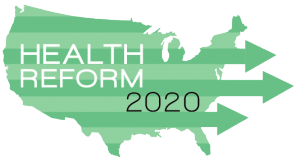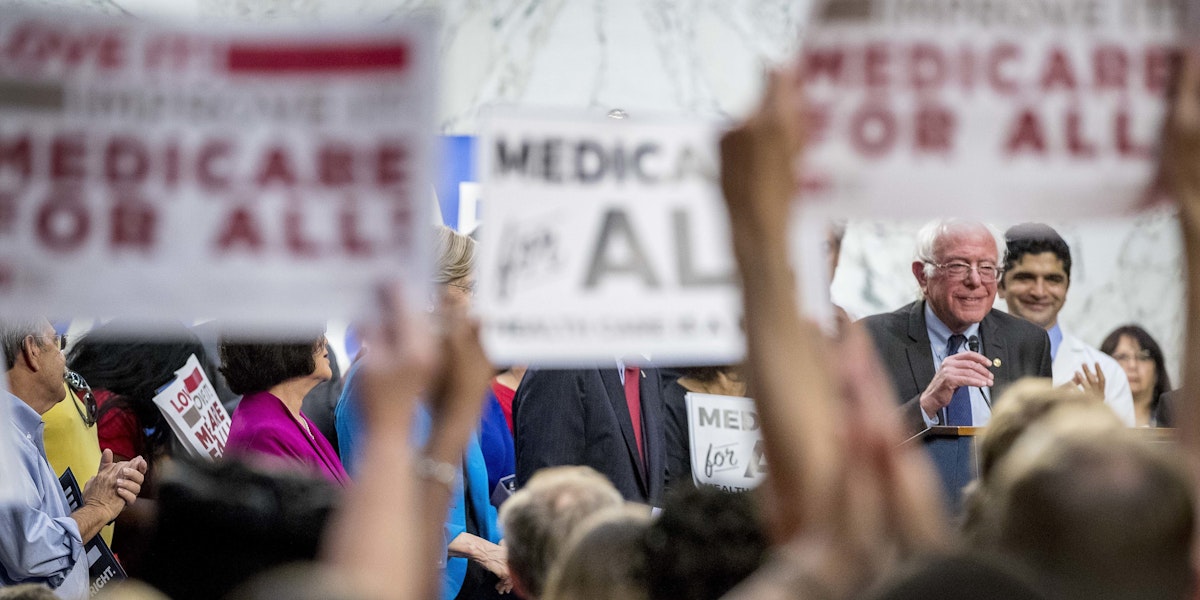With the failure (so far) of Republican efforts to repeal and replace the Affordable Care Act, emboldened Democrats are releasing proposals and drafting legislation that would expand coverage to some (or all) of the nation’s remaining uninsured. Most such proposals call for expanding Medicare, the federal program that covers the aged and disabled. The argument here, however, is that Medicaid, the federal-state program for low-income populations, offers the best path forward, from both a political and a policy perspective. Medicaid could be an affordable and attractive option for those buying coverage on the ACA exchanges, stabilizing markets that otherwise lack adequate competition and offering a realistic path to an American version of universal coverage.
Medicaid’s Political Resilience
During the last year, congressional Republicans mounted a concerted effort to shrink Medicaid by repealing the expansion under the ACA and putting the entire program on a fixed budget that would grow more slowly than medical inflation. With those proposals defeated for now, the Trump administration is encouraging states to adopt policies such as work requirements for non-disabled adults that offer a backdoor strategy to Medicaid cutbacks. The administration argues that Medicaid should return to its original roots as a welfare medicine program for poor children, the disabled, and the elderly.
At the same time, Medicaid has arguably emerged from the repeal-and-replace debate stronger than ever, its political strength clear. By a large majority, for example, voters in Maine this past November approved a referendum in favor of an ACA Medicaid expansion. Just a few months earlier in July, the Nevada legislature voted to permit any state resident to buy into Medicaid, and although the state’s Republican governor vetoed the bill, lawmakers in other states from Massachusetts to Iowa are drafting similar proposals. Indeed, the Medicaid director of a conservative Republican state told me that Medicaid in his state is far more popular than “Obama-care.” And at the national level, Hawaii Senator Brian Schatz has introduced legislation that would encourage all states to offer a Medicaid plan on their ACA insurance exchange.
What explains the popularity and political resilience of Medicaid? How has Medicaid evolved from its welfare roots to a program that today provides decent and affordable coverage to more than 75 million Americans, becoming in turn the nation’s most successful program for aiding the uninsured?
One explanation is that the program enjoys surprisingly strong interest-group support from providers (especially hospitals and nursing homes), insurers (especially those that participate in Medicaid managed-care programs), and employers (whose low-wage employees are often Medicaid beneficiaries). Indeed, savvy consumer-advocacy groups in Arizona let the local chamber of commerce take the lead (successfully) in lobbying Republican Governor Jan Brewer to support a Medicaid expansion.
How Medicaid is funded also contributes to its political durability. The federal government and the states share the cost, which incentivizes states to expand during good economic times (since the federal government pays most of the bill) but discourages contraction during bad economic times (since state dollars saved lead to federal dollars lost). To be sure, the lure of federal funding has not overcome political resistance in the 19 states that have so far declined to implement the ACA Medicaid expansion. Nonetheless, the Republican governors in Arizona, Nevada, Ohio, and other states that have expanded Medicaid were fierce opponents of the recent repeal proposals.
Finally, with more than 75 million enrollees, most Americans now know someone on Medicaid, which personalizes the program, and lessens the stigma associated with enrollment. This is especially so given the program’s popularity with its beneficiaries, and the increased recognition that it not only provides decent access to primary and acute care, but also is the nation’s primary payer for long-term care (for both the aged and the disabled) and the default insurance plan for the nation’s most vulnerable populations, including the homeless, mentally ill, and substance abusers.

Read all of the articles in the Health Reform 2020 series, co-produced by The Century Foundation and The American Prospect.
What About Medicare?
Many liberals prefer the Medicare model to its Medicaid counterpart. For starters, Medicare is a national program with uniform rules governing eligibility, benefits, and reimbursement, while Medicaid is a state-administered program, with a long history of (sometimes troublesome) inter-state variation. Medicare also is a social insurance program, viewed positively by most Americans as an “earned right,” unlike its means-tested counterpart, in which eligibility depends on income (and on fitting into eligible categories in states that have rejected the ACA Medicaid expansion). Medicare also pays higher reimbursement rates than does Medicaid, thereby making it more popular with providers. Moreover, lowering the Medicare eligibility age to 55 arguably would stabilize the exchanges by leaving them with a younger and healthier population. So why not coalesce around this incremental path, drawing on the inspiration of Bernie Sanders and the pragmatism of his more incremental colleagues?
One answer is sure, lowering the Medicare eligibility age to 55 (or even lower) is an excellent idea, but since it will not happen without Democratic control of the White House and Congress, why not encourage states to adopt a Medicaid buy-in right now? Perhaps a liberal state such as Massachusetts would target such a program toward persons with income too high to receive subsidized coverage on the ACA exchange. Or maybe a rural state like Montana would create a Medicaid plan to stabilize an exchange suffering from inadequate competition. Alternatively, what if the Republican leadership in a state that has not yet expanded its Medicaid program sees this as a backdoor strategy to such an expansion, offering a low-cost buy-in as a “marketplace” alternative to a more traditional expansion?
At the same time, the argument for relying on Medicaid as the best path to universal coverage rests on more than short-term political expediency. It is not an accident, for example, that for more than 30 years, Medicaid has regularly expanded its eligibility criteria, under both Democratic and Republican administrations, while Medicare eligibility has remained constant. Nor has the assumption that Medicaid would be the far more politically vulnerable program proved to be necessarily so. For example, the assumption that Medicare’s Trust Fund financing would provide political cover turned out to be wrong, as evidenced by the ongoing concerns that the program is soon to go “bankrupt.” While predictions of Medicare’s insolvency are vastly overstated, those concerns will have an impact on any effort to expand program eligibility, especially for current beneficiaries worried about the program’s long-term fiscal stability. Ironically, however, Medicaid’s reliance on general (federal and state) revenues provides unexpected political protection.
That Medicaid is administered by the states offers another important political advantage, shielding it from claims that it is a “big government” bureaucratic monolith. States have used their discretion to enroll most Medicaid beneficiaries in private managed-care plans, which provides additional political protection. Moreover, while states sometimes use their flexibility to cut back programmatic entitlements (proposals to impose work requirements may turn out to be one example), far more common are state experiments with novel approaches to care management, especially for the vulnerable populations the program serves. Nearly a dozen states, for example, are engaged in comprehensive efforts to restructure how care is delivered to the poor, encouraging collaborations with community-based social service organizations, and implementing efforts to deal with the so-called “social determinants.”
There also is a more practical argument for a Medicaid expansion strategy: The Medicaid benefit package and its managed-care delivery system are a better fit for the remaining uninsured than is Medicare, with its more limited benefits and its Medicare Advantage health plans.
There are of course political downsides to a state-led Medicaid buy-in strategy, and its success is far from assured. Doctors and hospitals complain about low payment rates. The stigma associated with the program’s welfare roots persists. Beneficiaries have trouble accessing certain specialty services, such as child psychiatry. The state-based flexibility has its downsides, as evidenced by the 19 states that have not adopted the ACA expansion, and the current wave of red-state waiver submissions. The strategy could reward states that have so far refused to adopt the ACA Medicaid expansion by giving them a backdoor way to pursue a more limited approach. States could even try over time to convert their entire Medicaid program into a buy-in, thereby undermining the legal entitlement of beneficiaries.
Despite these concerns, the lesson of the last 50 years is that the U.S. path to expanded coverage generally goes through Medicaid, adding groups by raising income thresholds incrementally, using shared governmental funding to finance these expansions, experimenting with care management strategies focused on our most vulnerable populations, providing an insurance safety net for public health crises (from AIDS to Flint), and relying on interest groups to carry much of the political weight. The state-led Medicaid buy-in approach could well be the next step on this path.
Eventually, however, federal action likely will be required to ensure that all states provide adequate coverage, either through an ACA Medicaid expansion, or through a separate buy-in program. Much like any effort to expand Medicare coverage, such an initiative at a minimum will require Democratic control of Congress and the White House. But there is a further obstacle to a Medicaid mandate: the Supreme Court’s decision in NFIB v. Sebelius, which struck down the Medicaid mandate in the ACA. Nonetheless, I believe Congress could get around that decision. Here’s why. The court held that Congress unconstitutionally threatened to pull “all” federal funding from the traditional (or pre-existing) Medicaid program if states did not participate in the “new” ACA Medicaid program. The court distinguished this “coercive” provision from a permissible funding condition, such as when Congress threatened to withhold 5 percent of a state’s highway funds if the state did not have a drinking age of 21. It is thus entirely plausible that new legislation imposing a milder penalty—say 10 percent to 15 percent of federal funding—could be classified as noncoercive. To be sure, some states could still opt out, but the odds of them doing so are small.
How Would a Medicaid Buy-In Program Work?
Proponents of the Medicaid buy-in strategy generally call on states to create a “Medicaid plan” that would be offered as an option on the various ACA exchanges. How this would work is less clear. Indeed, there is no single model, which is one of the strengths of the approach. Before proceeding, states would need to consider a host of issues—the devil will be in the details. At the same time, the various options offer a policy menu for a laboratory of federalism.
What is the target market? Would the program permit anyone in the state to buy in, including employers, or would it limit enrollment to those on the individual market or perhaps to those with income below a certain level? Alternatively, a state could offer the buy-in to a specific group, such as the parents of children enrolled in CHIP.
What would be included in the benefit package? If sold on the ACA exchange, the benefit package would need to meet ACA standards (including the “essential health benefits”), but states might well exclude certain traditional Medicaid benefits such as long-term care support services.
How would premiums be set? Should there be a cap on the percentage of income charged as a premium?
What would the delivery system look like? Would the new plan subcontract to existing Medicaid managed-care plans? If those plans are already on the exchange, they might be required to take on this additional population.
How much would the Medicaid plan pay providers for treating buy-in enrollees? Participating providers might receive some sort of reimbursement bump-up.
Would the premiums cover the true cost of enrollment, and if not, how would either the state or federal government subsidize the additional cost? One possibility would be for eligible individuals to use their ACA tax subsidies to pay part of the premiums.
How would the new Medicaid buy-in deal with adverse selection (the likelihood that sicker folks would be more inclined to buy in to the program)? One answer is a strengthened individual mandate, though states might also consider tools such as reinsurance, risk adjustment and risk corridors, the same strategies that were included in the ACA. The problem of adverse selection, however, is potentially less pressing for a vast program like Medicaid than for much smaller markets such as the ACA exchanges.
How much inter-state variation should the federal government permit or perhaps encourage? While states ought to be able to vary benefit packages and premiums, national standards may be necessary for some critical areas, such as payment levels for primary care and eligibility criteria.
Medicaid and the Path to Universal Coverage
The partisan rancor over the future of the American health-care system reflects a broader debate over the role of government and also the division of labor between the federal government and the states. The effort to repeal and replace the Affordable Care Act emerges from a view that the federal government has overstepped its legitimate role and that health-care markets could and would be more competitive and more successful with far less government interference. In contrast, those who support the law, and the effort to move the nation closer to universal coverage more generally, start from the premise that access to decent health care is a basic right of citizenship that can be realized only by deliberate government action.
The nation will not resolve this debate anytime soon; we have long had different versions of this same argument. Indeed, the political conflict over the appropriate role for government is likely to increase during the remaining years of the Trump administration, given its ongoing efforts to scale back the size and scope of the public sector.
The election of 2020 may produce a Democratic administration that is able to overcome this partisan divide and enact federal legislation moving the nation closer to universal coverage. In that scenario, nearly any of the proposals to expand either Medicare or Medicaid would be desirable, and the Democrats ought to have the various alternatives ready for such a window of opportunity.
States, however, do not need to wait till 2020 to begin expanding coverage. We should encourage the 19 states that have not yet enacted the ACA Medicaid expansion to do so. The recent referendum in Maine suggests political opportunity on that front. In addition, different versions of a Medicaid buy-in could both stabilize the ACA exchanges and also provide health insurance right away to low- or middle-income persons who need it.
Medicaid is the longstanding heart of the nation’s effort to aid the uninsured, and it remains our most plausible path to universal coverage. We should thus push for a Medicaid buy-in strategy, as a way of providing immediate assistance to some and continuing our incremental path to better coverage for all.
 This article was published as part of a special report on health care reform, co-produced with The American Prospect.
This article was published as part of a special report on health care reform, co-produced with The American Prospect.










